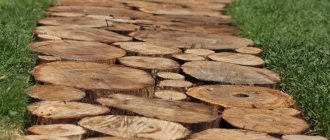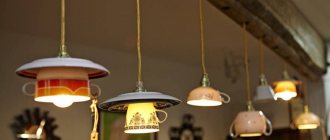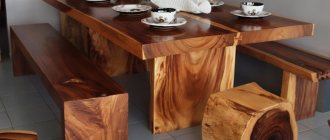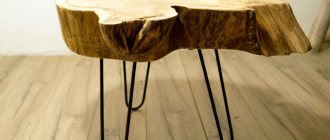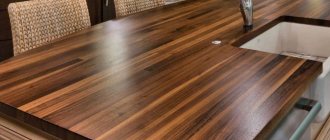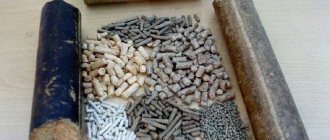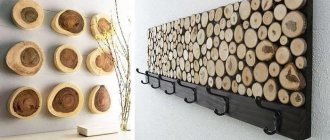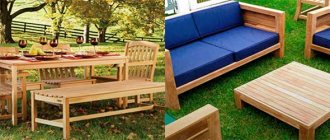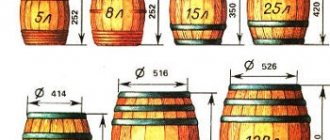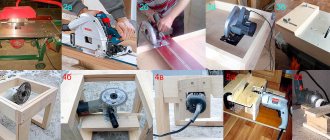Nature is the most perfect creator. Each of her drawings, each form is unique. Designers skillfully use this, complementing sophisticated or high-tech interiors with objects as close as possible to their natural state.
Meanwhile, everyone can see the unique true beauty in an ordinary piece of wood, a stump, a branch, skillfully highlight it with their own hands and find the best place for use in their own home, at their summer cottage, in the garden. A large or small table, made from a longitudinal or transverse cut of wood, will become the highlight of your living space.
What will you need for your job?
To make an original table from a vertical cut of wood with your own hands, you need to prepare:
- A cut of dry wood with approximate dimensions of 1700x600 mm, 25 mm thick.
- Metal (steel) plate about 600x35x3 mm.
- 4 steel rods with a diameter of 9 mm, length 1.5 m.
- Epoxy resin (transparent).
- Wax, varnish for a transparent finishing coat of wood.
- Black spray paint.
- Screws No. 12 (1.9 cm).
- Painting tape.
- Grinding machine.
- Sandpaper of different grits.
- Hammer.
- Chisel.
- Drill.
- Welding machine.
- Protective gloves and glasses.
What is good about a table made from sawn wood?
Before we talk about how to make such a table yourself, you should understand why you need to pay attention to it in the first place. So, first of all, it should be noted that furniture made of wood is an environmentally friendly and natural product. To make such a table, you only need a tabletop, the role of which will be played by the end cut of a thick tree trunk, as well as what will play the role of legs. These can be metal supports or supports made of wood.
Table made from cut oak
On a note! Sometimes you can take a whole piece of driftwood suitable for the parameters and make a table directly from it, where the root part will serve as a kind of support, and the even cut itself can be decorated and made into a tabletop.
Table made from cut birch bark
Another undeniable advantage of a table made from sawn wood is that it can fit into a number of different interiors. So, it will look good in an ecological style, country style, it will fit perfectly into the kitchen or living room, and in the country it will become the optimal addition to the house.
Coffee table made from cut wood
It is also worth understanding that the pattern of the tree, although it will be similar to other cuts, will still remain unique and inimitable. And it will still be different for different trees.
Making a table from cut wood yourself is quite simple - you don’t have to resort to the help of craftsmen and designers. It is enough to allocate a little time and make some efforts, and a unique and inimitable, unusual and beautiful product will appear in the house.
Making a table from cut wood yourself is quite simple.
Important! Such a table will look wild in some interior styles. So you must definitely decide in which room it will stand and whether it will fit into its style, if the decision was made to make such a table.
Description of work
It should be noted that the wood from which the table will be made with your own hands must be well dried. Otherwise, during operation, unevenness and cracks may appear on it.
- Use a chisel and hammer to remove the bark and cut off any loose fibers that are located along the edge of the tree.
- Use a sander to thoroughly sand the surface and ends of the material. To make them as smooth as possible, you should continue sanding by hand, alternating sandpaper of different grits (first coarse, then fine).
- The surface of the table should become absolutely flat, so you need to remove all the cracks and cut depressions. Cover the areas to be treated with masking tape. Fill the uneven areas with epoxy resin, heating successive layers with a blowtorch. This will prevent air bubbles from forming in the resin.
- When the resin has completely hardened, smooth it to the surface of the wood using sandpaper.
- Cut the prepared steel plate into 8 identical elements (10 cm each). Then weld them in pairs, forming corners. Sand the weld seam. If such work is difficult for you, you can find similar ready-made products.
- You need to make table legs from steel rods. Bend the metal rods in the middle. Then weld their ends to the ends of the metal corners.
- Using a drill, prepare 2 holes in the corners, with which we will attach the steel legs to the wooden tabletop.
- Paint the finished legs with black paint.
- Proceed to finishing the cut of the tree. The entire surface should be coated with matte transparent varnish.
- Polish the surface of the future table with wax.
- All you have to do is attach the legs with screws to the table.
A table made with your own hands from a vertical cut of wood can be used as a small dining table or a sleek workstation with a computer. You will definitely appreciate the advantages of its original shape and attractive appearance.
General requirements for wood
Our future craft from a stump or log should initially be dry wood. Fresh wood must be dried for at least 1-2 months at a temperature of 15-25 degrees. It is best in a dry room and/or without direct sunlight, otherwise our stump may crack and crafts from it may not work.
Frankly rotten stumps or logs should not be taken, but if the stump is a little rotten on the outside, such a stump can be used by treating it with a grinder and a brush, removing the rotten layer from it, in which case something can be made from it. Before drying the stump, the bark can be removed, for which it is convenient to use a chisel and a hammer or an ax, or you can leave it, it will need to be well treated to prevent rotting, for example, with iron sulfate and varnish.
Stump for crafts
If you have a stump on an area that you have long wanted to uproot, be sure to do it, or use it untouched, grown into the ground - this option is also applicable for making a table or chair from a stump or decorative crafts for the garden.
I recommend: How to deal with flooding of land adjacent to a lake
This completes the general requirements for the wood of stumps and logs, now let’s look a little at the processing methods.
Decoration of any interior
Many horizontal rounded cuts of wood are now actively used as decoration for walls, floors and, of course, in the production of tables, chairs, and other furniture. Tables finished using this technique are unique; the arrangement of small and large cut circles can be arbitrary or form a specific pattern.
Making a beautiful product with your own hands is not easy, but very interesting. And if you follow all the requirements for the work, the result will please you.
Wooden cuts
Previously, small tree cuts that were so useless to anyone went into the furnace. Now, various products from wooden saw cuts are at the peak of their “boom”. Not just like that.
Items made from wood cuts look very beautiful and very solid. Free material, in the form of dry branches in the forests, is another plus for various kinds of products from saw cuts.
- Garden paths are made from saw cuts
- Floors in the house are made from saw cuts
In today's article, we will tell you step by step how to make a table from wooden saw cuts
Materials and tools
- Tabletop. It will serve as the basis for the arrangement of wood cuts. You can use an old piece or prepare the shape you want from a piece of moisture-resistant plywood (12mm). This material is preferred, it will not change shape and will provide a flat surface for DIY decoration of the main part of the table.
- The required number of horizontal (end) cuts. They can be selected from the same type of wood or from different ones in order to play it off in an interesting way in the drawing. It is advisable to have different cut diameters (from large to small), in this case they can be stacked more closely together. Each cut should be no more than 1 cm thick. Otherwise, more epoxy resin will be needed.
- To fill the free space left after laying the cuts, you will need high-quality epoxy resin with a hardener.
- Wood glue (suitable for all types of wood). With its help, each section will be separately attached to the tabletop with your own hands. Purchase a container up to 300 grams.
- Finishing varnish.
- A grinding machine with wheels of different grain sizes - from 120 and more.
Preparing the mold for filling the table with epoxy resin
I laid the slab halves on plastic film on a workbench and fixed them with their uneven sides facing each other using plywood slats, which were previously wrapped with tape and treated with wax. There was a small distance between them, into which it was planned to pour epoxy resin.
The original plan was to make the table narrower, but it was not possible to purchase a small canister of resin. Therefore, I decided that there would be nothing wrong if the product was a little wider. To avoid leakage of epoxy resin, I coated all possible cracks with ordinary silicone sealant, and covered the film between the boards with wax, which made it uneven (the mistake I mentioned). In the future, if I start making another table like this, I should use hard plastic instead.
The slab cuts were fixed on a workbench covered with plastic film, and all joints were coated with sealant
Final steps to prepare the mold for pouring
The same sealant was used to “lay” strips designed to prevent the resin from spreading over the wood. I didn't want to create a completely glossy surface, so I needed to prevent the epoxy from bleeding onto the sanded wood.
Boundary strips of sealant on wood
sealant
All that remained was to tightly fix the parts of the slab on the workbench using clamps. But you need to keep in mind that their small platforms can push through the elm, and it will have to be polished again. It is better to cut small squares from the same plywood and place them between the wood and the clamping part of the clamp.
We press the wood with clamps to the workbench
Step-by-step instruction
The process technology is reminiscent of creating an applique on wood. Before starting work, you need to inspect the existing carpentry tools and purchase the required number of cuts.
Step 1. Choosing a style concept
Despite the versatility of wood as a joinery material, it is not suitable for all applications.
Table 2. Recommendations for choosing a style
| Style | Description |
| It is distinguished by respectability and the predominance of dimensional structures. Massive furniture is made from expensive types of wood - cherry, oak, larch, cedar. The products are decorated with figured elements, which give it a special chic. |
| Rustic style is characterized by simplicity and extreme functionality. Tables are installed mainly in living rooms or dining rooms. The main differences between the direction are the avoidance of clear lines and pretentiousness. Preference is given to natural shades. The products are characterized by roughness of execution and lack of finishing. Furniture is often subjected to artificial aging techniques. As a result, it looks shabby and worn. |
| The products are characterized by maximum proximity to nature. Unlike the previous direction, they have smoother and more elegant forms. |
| One of the most optimal options for furniture decorated with saw cuts. The harsh climate of the northern countries is embodied in laconic forms and clear lines. The furniture is reliable, solid and practical. Interior items are exclusively of an applied nature. |
| Covering from saw cuts is a technology often found within the oriental style. The combination of a wood base and forged legs is popular. |
| The emphasis is on simple shapes, straight lines and the absence of decorative elements. The furniture is exclusively utilitarian in nature. |
| One of the features of this direction is the updating of old interior items. Decorating structures with sawn wood is considered the most popular technique. Preference is given to tables with a rectangular tabletop and chrome legs. |
Among the styles into which a product made from cut wood will not fit is high-tech. There is an article on our portal that describes in detail the features and design options of the high-tech style.
Step 2. Selecting a Palette
The shade of the cut surface should match the overall color scheme of the room.
Table 3. Matching tone and wood species
| Light | Redheads | Dark |
|
|
|
If you need a shade different from the original, colored varnish or paint is applied to the wood.
Wenge wood structure
Every decade, the fashion for furniture color changes. If a few decades ago light colors were the priority, recently preference has been given to a dark palette.
Beech structure
Step 3: Select a design
When deciding on the shape of the table, take into account the dimensions of the room.
Table 4. Product classifier based on design features
| Variety | Description |
| Universal and most popular. Makes it possible to design portable and folding structures. They look great in any interior. In rooms with small square footage they look good near the wall. In spacious halls they look good in the center. |
| Suitable for small families. Due to its compactness, no more than 4 guests can be seated at the tabletop. The optimal model for kitchens. The number of seats is less than in oval ones. |
| A type of construction that is installed mainly in spacious rooms. Since there is no possibility of docking with a corner or wall, it is advisable to place it in the center of the room. |
| An ideal option for a large family. Due to the absence of corners and the possibility of using folding systems, it is convenient for receiving guests. |
There is a classifier based on the functionality of the product:
- Computer. A complex system that requires a compartment for the system unit and a panel for the monitor. Some models have a retractable shelf for the keypad.
- Magazine. Compact tables, the tabletop of which is located a short distance from the floor. There are designs with both carved and wide legs.
- Written. One of the types of desks for working at a computer. The models are characterized by a large working surface area. There are drawers for storing documents or built-in cabinets. Often such designs are decorated with figured elements.
- Farmer's. A traditional table for eating. The massive tabletop is equipped with a drawstring belt.
- Monastic. Popular for furnishing rooms in private homes. One of the main differences is the wide working surface.
- Secretaire. This type of cabinet furniture is a mini-wardrobe with a folding tabletop. Serves as an alternative to a desk. Practical and multifunctional model.
- Lunch. Both stationary and transformers are produced. They are found mostly oval in shape.
For small rooms, there are models that combine the functions of a desk and a dining table.
A table designed for working and eating
Among the multifunctional products, users highlight a table-shelf, in which the height of the tabletop is manually adjusted. The body can be either metal or wood. Ideal option for small spaces. When unfolded, they can accommodate a large number of people.
Depending on the number of legs, there are several main varieties:
- single-support - one massive leg;
- bipedal - 2 supporting elements;
- traditional - 4 supporting elements.
The last option is considered the most stable. The table can also be installed on 3 legs, but this type of support is the least popular.
Unusual shape of legs
Step 4. Combination of wood with other materials
Untreated wood combines well with plastic, glass and metal.
Features of use:
- To add elegance to the structure, the legs are made of forged metal elements.
- Products that combine inclusions of genuine leather look original. The heads of the nails used for upholstery make them similar to medieval European tables.
For connoisseurs of elegant interior items, a table with mosaic inserts made of ceramic or glass is suitable. Depending on the chosen pattern, a style concept is selected.
Metal support
Step 5. Material selection
The number and dimensions of cuts are determined by the size of the table base. In addition, you need to take into account the features of the planned tabletop pattern. Based on the listed criteria, the necessary material is selected. You will also need a sheet of plywood to make the base.
It is advisable to purchase ready-made sections. Since they are sold in a finished form, there is no need to sand the composite elements. Wood appliqué elements can be purchased at a sawmill or found a supplier on the Internet. For some types of countertops, a solid cut is suitable. This option is more convenient to use, but it is difficult to select a bar of suitable diameter.
Oak cut
Harvesting lumber yourself requires a lot of time and effort. At the slightest mistake, the work will have to start again. Cracked elements are not suitable for work. The optimal cut size is 30 cm in diameter and 5 cm in thickness.
Choosing a wood species
Selecting a cut
To create a unique composition, you can select sections of different sizes and species (birch, pine, spruce, pear, juniper, etc.). The pattern of the part largely depends on the sawing technology. Since this aspect is of key importance, you should familiarize yourself with its varieties.
Tree cutting occurs in 3 directions:
- Transverse (frontal, end) section. It is carried out perpendicular to the axis and direction of the fibers.
- Tangential (chordate). Along the chord along the trunk. Perpendicular to the barrel radius and medullary rays.
- Radial (mirror). The cut runs parallel to the trunk along the medullary rays.
Main cuts in the trunk
Depending on the direction of the cut, the texture of the wood will change. Quality characteristics also differ. The natural pattern preserves the cross section.
Creating a designer wall
For decoration, it is advisable to choose one side of the room. The design of all planes is a sign of bad taste, and the room will look overloaded. Any room needs to be given air, and it’s not about the windows. It should breathe space, and light empty planes give this effect. Only one “woody” edge of the room will become a kind of accent, which will become its mood. You can lay out the “wood puzzle” yourself, and now we’ll talk about how it’s done.
Everyone has a dead tree in their yard that needs to be removed. Now it's time to chop it down. We take a branch and cut it into bars of medium thickness. You can remove the bark from the resulting “pancakes” and then sand it. Thanks to this, you will not drive a thorn when touching the wall. The resulting wood layers should be treated with a special insect repellent, and then placed on glue. It is advisable to varnish the resulting relief - varnished wood can last a long time.
